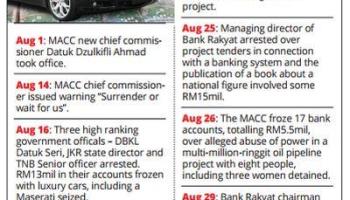Unemployment in Malaysia is rising, the latest data released by the Statistics Department show.
The obvious correlation to the rise in the jobless rate, which in Malaysia is counted as those who are unemployed but remain actively looking for a job, is the slower pace of economic growth.
The economy, up until the second quarter ended June 30, has slowed for five quarters in a row with weak exports the main drag on growth.
Although private consumption and investments supported the economy in the second quarter, economists are not very confident that this will drive growth in the coming quarters without supportive government policies and improvement in overseas consumer demand.
This will have implications for jobs and the economy.
There could be reason for short-term cheer with data exceeding expectations, as August trade data released yesterday show but there are indications that downside risks remain.
Positive sentiments as reflected in the Malaysian Institute of Economic Research’s (Mier) business conditions index, which is now above the 100-point threshold, indicating that businesses’ confidence levels are up, can just as easily dissipate.
Consumers do not share the same sentiments as businesses, as the Mier’s consumer sentiments index show.
Although rising steadily since the beginning of the year, the index is still below the 100-point threshold, largely reflecting benign inflation and the fading impact of the goods and services tax implemented last year.
Standard Chartered plc Asean economic research head Edward Lee says private consumption growth momentum will not be sustainable because of the weak labour-market conditions.
Besides the higher unemployment rate, weak wage- and job-growth together with the slowdown in the property market and financial-market volatility to also affect spending sentiment.
Lee, who expects the economy to grow 3.8% this year compared to the official estimates of 4% to 4.5%, adds that the weakening labour market will be a drag on economic growth.
“Private consumption will be key to achieving this target, and we think it may come in weaker than the central bank expects due to weaker labour-market conditions.
“We will therefore monitor consumption metrics closely over the next few months,” he says.
Cautious consumer sentiment largely reflects the state of the job market and high household debt.
 Different views: Consumers do not share the same sentiments as businesses, as Mier’s consumer sentiments index shows.
Different views: Consumers do not share the same sentiments as businesses, as Mier’s consumer sentiments index shows.Data from Bank Negara and the Nikkei Malaysia manufacturing purchasing managers index (PMI) compiled by IHS Markit Ltd paint a bleaker picture.
While the September Nikkei Malaysia manufacturing PMI, which was released at the end of last month saw an improvement from August, it is still below the 50-point threshold, indicating that the manufacturing sector is still contracting.
But what is interesting is the press statement following the release of the August data, in which IHS Markit economist Amy Brownbill says the Malaysian manufacturing sector saw a sharper deterioration in operating conditions underpinned by quicker declines in output, new orders and employment with the rate of job shedding the fastest in over three years.
The August PMI report noted that firms cut back on payroll numbers as part of efforts to make cost savings.
Bank Negara report
A Bank Negara report also showed that labour market conditions have become challenging, with the recent high unemployment rates coinciding with lower job vacancies available per active job seekers.
AllianceDBS Research chief economist Manokaran Mottain said in a report released last week that while the manufacturing sector was shedding jobs, selected services subsectors has added headcount and could be cushioning job losses in the manufacturing sector.
More than half of the workforce are employed in the services sector with the manufacturing sector employing about 16%.
Further evidence of the deteriorating conditions in the job market comes from the Employees’ Provident Fund (EPF).
Manokaran says the monthly contribution value growth rate from the EPF’s members have moderated, signalling weak wage growth in recent years.
This also mirrors the slowdown in the economy over the past few quarters as businesses will not give higher increments or pay out bonuses.
Manokaran says based on trend-growth estimates, seasonally and inflation adjusted monthly EPF contribution growth has tapered to 2.7% in February on a year-on-year basis before the voluntary employees contribution rate reduction effective in March, down from around 10% growth in 2011.
He noted that while average household income grew 9.6% per annum between 2012 and 2014 in inflation adjusted terms based on the Statistics Department’s household income survey, this was largely propped up by government cash transfers (Bantuan Rakyat 1Malaysia payments) to the bottom 40% of earners.
“On average, given that 65% of household income is from paid employment, signs of wages growth moderation could weigh on household income growth going forward,” Manokaran says.
He adds that the state of labour market and income growth are among the key underlying factors in assessing the state of economic growth outlook.
Earlier this week, the World Bank slashed its growth forecast for Malaysia from 2016 to 2018 on the weak exports and commodity-price outlook. Its chief economist for the East Asia and Pacific Region, Sudhir Shetty, says despite the region’s favourable prospects, growth is vulnerable to a sharp global financial tightening, a further slowdown in world growth or a faster-than-anticipated slowdown in China.
By Fintan Ng The Star/ANN
Related:
BNM governor: Take long-term view on adjustment of ringgit
Ombudsman for financial services starts Oct 1
Sabah corruption – another reason why the ringgit is weak
Related posts:

https://youtu.be/01stOYgM9x0 It was a record haul by the Malaysian Anti-Corruption Commission – RM114mil seized from two top officer...
Jabatan Air Negeri Sabah - http://malaysianlogo.blogspot.my/2014/06/jabatan-air-negeri-sabah-sabah.html KOTA KINABALU: Everywhere in Sab...
Jabatan Air Negeri - Customer Service How the millions were
stolen? 1. Contracts broken down to small packages of RM100,000 ea...
PBA in a fix over Penang water cut; billion litrea Water waste via leaky pipes
PBA in a fix over Penang water cut; billion litrea Water waste via leaky pipes











